A Visual Try-On Experiment Across Cultures
As I began exploring the intersection of AI and Chinese aesthetics at Central Saint Martins, I was particularly curious about one key question:
Can AI-generated images authentically express the essence of Chinese fashion—and will global users recognize it as such?
To investigate this, I designed a small-scale visual intervention combining AI try-on technology with quick interviews. The results were surprising, insightful, and at times, culturally revealing.
The Experiment
Using Lavie AI, a virtual outfit simulation platform, I generated six images of models with different skin tones and body types wearing traditional clothing:
- 4 Chinese-style looks (e.g. stand-up collars, frog buttons, Tang/Song silhouettes, red and white color tones)
- 1 Japanese look (loose-fit linen kimono style)
- 1 Korean look (hanbok-style garment)
Then, I invited five people from different national and cultural backgrounds—including classmates and family members from Colombia, Indonesia, Iran, and the UK—to review the images. Each of them was asked:
- Which image looks most “Chinese-style” to you? Why?
- Which image is the most visually appealing to you? Why?
- Would you be interested in clicking or learning more about the outfit or brand if you saw it online?
Interview Snapshots: Real Reactions
I collected their answers via WhatsApp chats and voice notes. Here are some excerpts from the interviews:
Simon (Colombia):
Picked image 4 as the most “Chinese” due to the setting and model appearance. Found image 5 the most visually striking because of the cultural contrast (Black model in Asian-style outfit).
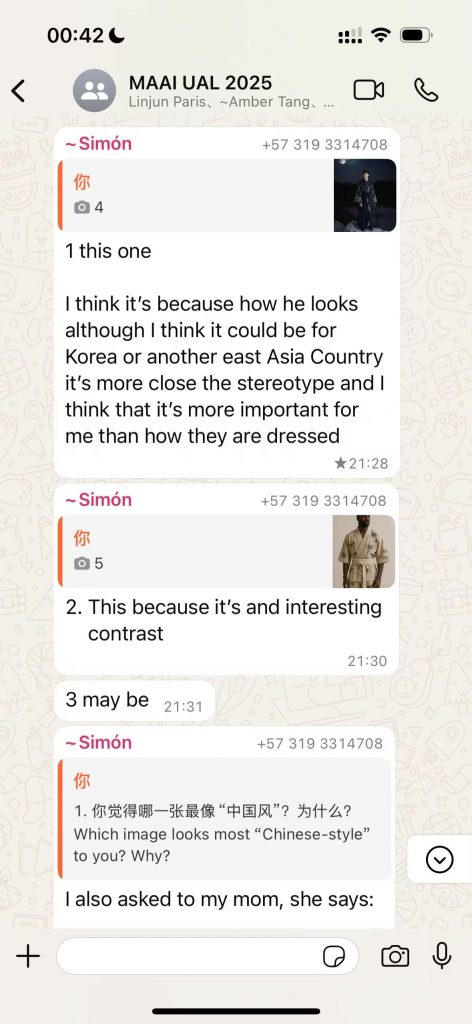
Sasha (Indonesia):
Recognized image 4 for its traditional elements. Said image 1 looked “authentic and wearable
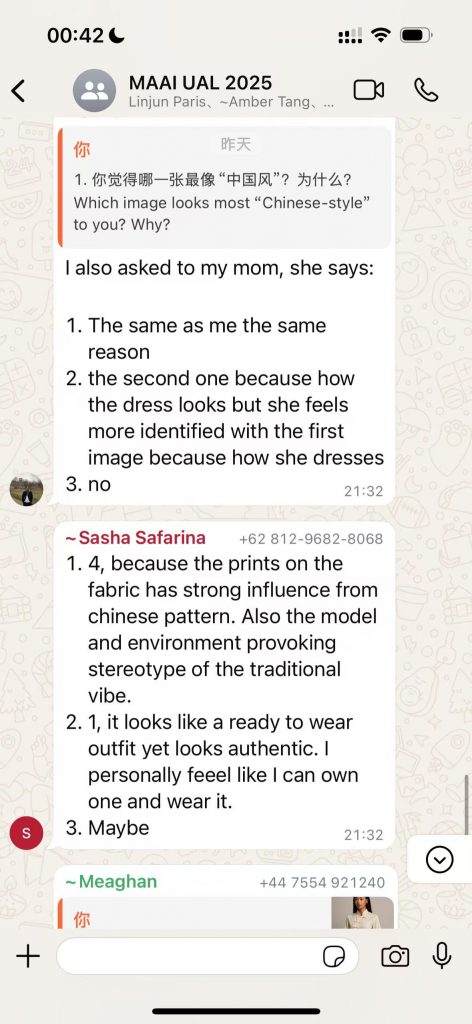
Meaghan (UK):
Noted that the frog buttons and stand-up collar on image 1 reminded her of a qipao. Liked the elegance of image 4.
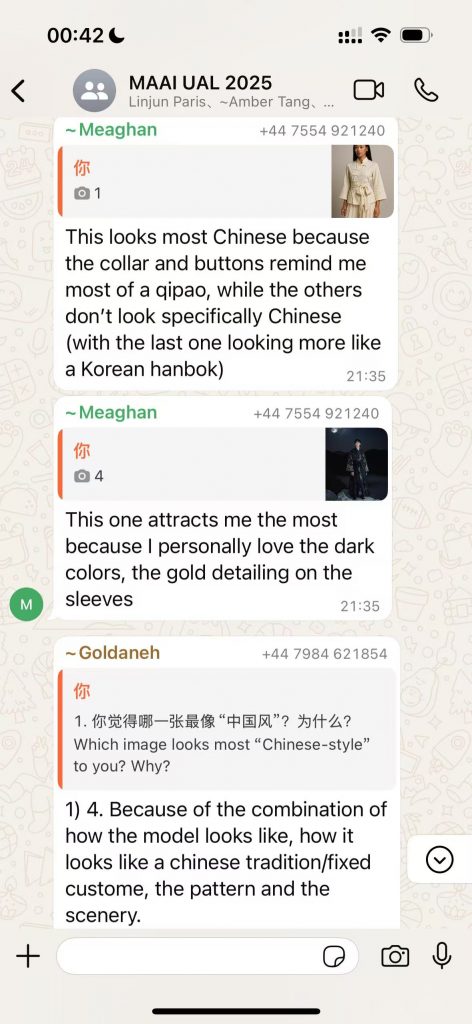
Goldaneh (Iran):
Picked image 4 for its patterns and composition. Felt it conveyed strong traditional Chinese visual language.
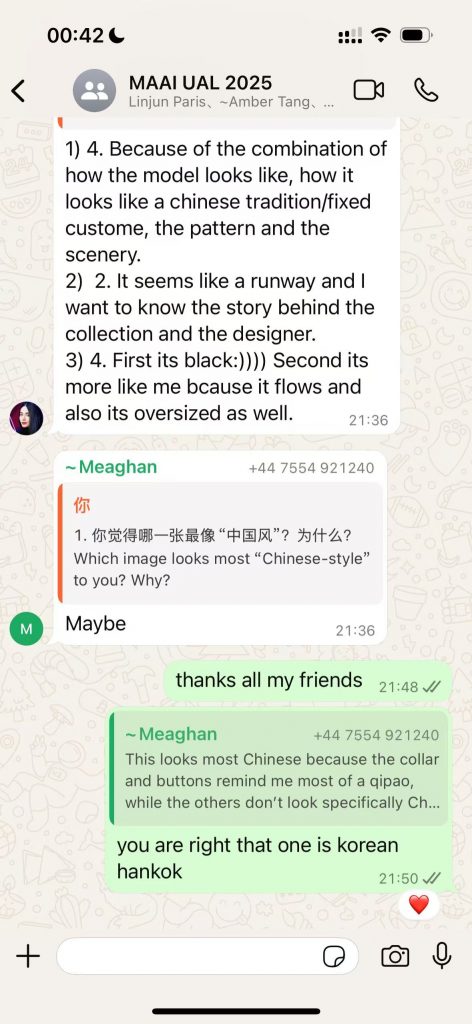
Simon’s Mom (Colombia):
Believed image 1 looked traditionally Chinese. Appreciated its simplicity and elegance.
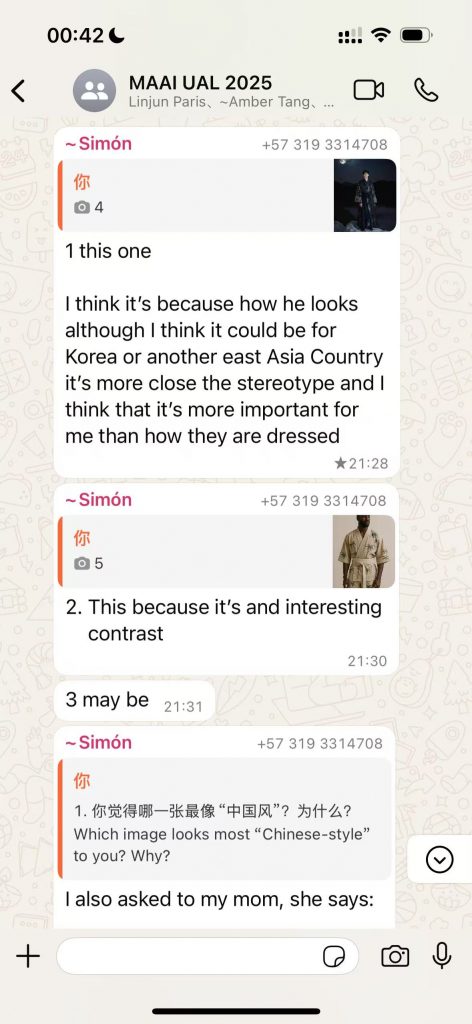
Key Insights
Cultural Bias & Misidentification
- One participant mistook the Japanese outfit for Chinese, indicating how Asian styles are often visually conflated in the global imagination.
- Another successfully identified the Korean hanbok.
- Many respondents based their judgments not only on clothing details, but also on model ethnicity and background setting, showing how race and context affect perception.
Visual Preferences
- Images combining traditional elements with modern simplicity were more appealing.
- Participants appreciated subtle elegance and familiar cultural patterns (e.g., buttons, collars, color tone).
What This Means for AI, Design & Culture
AI Has Cultural Expressive Potential
Despite being algorithmically generated, LavieAI’s visuals were widely recognized and appreciated for their cultural tone—supporting the idea that AI can serve as a translator of aesthetics.
Cultural Misunderstandings Remain Common
The confusion between Japanese and Chinese outfits highlights the need for visual literacy and educational framing, especially when working across cultures in fashion.
A New Opportunity for Design Communication
This experiment also reinforced my broader goal: to help Chinese aesthetics break out of outdated or kitschy tropes, and reintroduce its elegance through modern, intelligent tools—like AI.
Next Steps
Going forward, I aim to:
- Explore building a localized aesthetic database for more accurate cultural modeling
- Work with LavieAI on expanding visual outputs that better distinguish cultural codes
- Combine AI-generated images with narratives, color theory, and symbolic tags so global users can understand the “why” behind each look
Related Research & References
- Guo & Xiao (2022) – Research on Chinese Aesthetics in Fashion
- Triyanto et al. (2017) – Aesthetic Adaptation as Cultural Strategy
- Kexin Li (2024) – AI and Cultural Dissemination
- Loewe × Jingdezhen – Chinese Monochrome Collection
Would you have made the same guesses?
What does “Chinese style” mean to you in 2025?
Share your thoughts below.
Leave a Reply